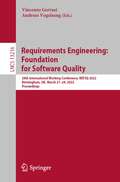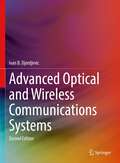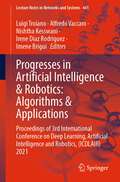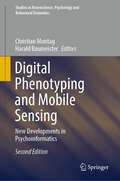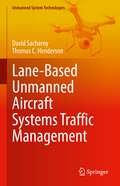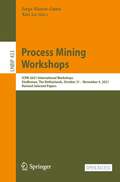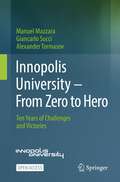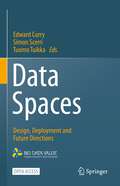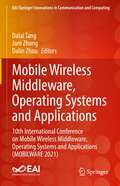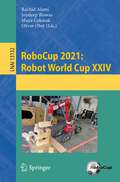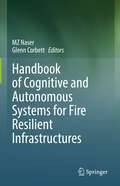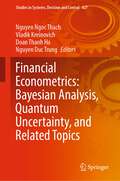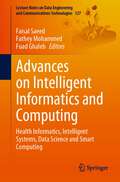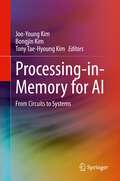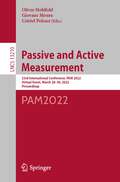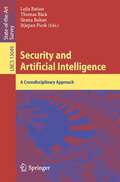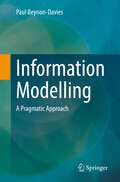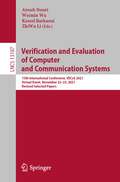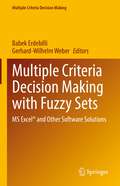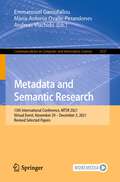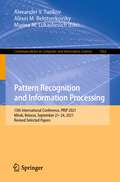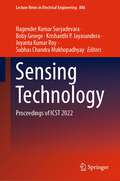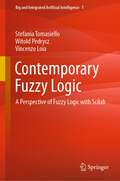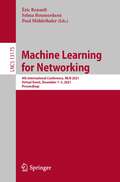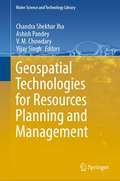- Table View
- List View
Requirements Engineering: 28th International Working Conference, REFSQ 2022, Birmingham, UK, March 21–24, 2022, Proceedings (Lecture Notes in Computer Science #13216)
by Vincenzo Gervasi Andreas VogelsangThis book constitutes the refereed proceedings of the 28th International Working Conference on Requirements Engineering: Foundation for Software Quality, REFSQ 2022, which was held in Aston, Birmingham, UK, during March 21-24, 2022. The 12 full and 7 short papers presented in this volume were carefully reviewed and selected from 45 submissions. They were organized in topical sections as follows: Artificial intelligence and explainability; machine learning; natural language processing; user stories; business, markets, and industrial practice; and cognition and expression. The special theme for REFSQ 2022 was "Explainability in Requirements Engineering".
Advanced Optical and Wireless Communications Systems
by Ivan B. DjordjevicThe new edition of this popular textbook keeps its structure, introducing the advanced topics of: (i) wireless communications, (ii) free-space optical (FSO) communications, (iii) indoor optical wireless (IR) communications, and (iv) fiber-optics communications, but thoroughly updates the content for new technologies and practical applications. The author presents fundamental concepts, such as propagation principles, modulation formats, channel coding, diversity principles, MIMO signal processing, multicarrier modulation, equalization, adaptive modulation and coding, detection principles, and software defined transmission, first describing them and then following up with a detailed look at each particular system. The book is self-contained and structured to provide straightforward guidance to readers looking to capture fundamentals and gain theoretical and practical knowledge about wireless communications, free-space optical communications, and fiber-optics communications, all which can be readily applied in studies, research, and practical applications. The textbook is intended for an upper undergraduate or graduate level courses in fiber-optics communication, wireless communication, and free-space optical communication problems, an appendix with all background material needed, and homework problems. In the second edition, in addition to the existing chapters being updated and problems being inserted, one new chapter has been added, related to the physical-layer security thus covering both security and reliability issues. New material on 5G and 6G technologies has been added in corresponding chapters.
Progresses in Artificial Intelligence & Robotics: Proceedings of 3rd International Conference on Deep Learning, Artificial Intelligence and Robotics, (ICDLAIR) 2021 (Lecture Notes in Networks and Systems #441)
by Luigi Troiano Alfredo Vaccaro Nishtha Kesswani Irene Díaz Rodriguez Imene BriguiThis book presents new technologies and applications in deep learning, artificial intelligence and robotics. The field of machine intelligence (MI), unifying robotics and artificial intelligence is experiencing constant growth and change. The challenge to reproduce human behavior in machines requires the interaction of many fields, from engineering to mathematics, from neurology to biology, from computer science to robotics, from web search to social networks, from machine learning to game theory, etc. This book Progresses in Artificial Intelligence & Robotics : Algorithms & Applications (proceedings of 3rd International Conference on Deep Learning, Artificial Intelligence and Robotics (ICDLAIR) 2021 ) introduces key topics from artificial intelligence algorithms and programming organization and explains how they contribute to autonomous capabilities. The book is primarily intended for researchers, students, and engineers who wish to use the applications of artificial intelligence to solve concrete problems. We hope that companies and technology developers also find it interesting to be used in industry.
Digital Phenotyping and Mobile Sensing: New Developments in Psychoinformatics (Studies in Neuroscience, Psychology and Behavioral Economics)
by Christian Montag Harald BaumeisterThis book offers a snapshot of cutting-edge applications of digital phenotyping and mobile sensing for studying human behavior and planning innovative e-healthcare interventions. The respective chapters, written by authoritative researchers, cover both theoretical perspectives and good scientific and professional practices related to the use and development of these technologies. They share novel insights into established applications of mobile sensing, such as predicting personality or mental and behavioral health on the basis of smartphone usage patterns, and highlight emerging trends, such as the use of machine learning, big data and deep learning approaches, and the combination of mobile sensing with AI and expert systems. Important issues relating to privacy and ethics are analyzed, together with selected case studies. This thoroughly revised and extended second edition provides researchers and professionals with extensive information on the latest developments in the field of digital phenotyping and mobile sensing. It gives a special emphasis to trends in diagnostics systems and AI applications, suggesting important future directions for research in public health and social sciences.
Lane-Based Unmanned Aircraft Systems Traffic Management (Unmanned System Technologies)
by David Sacharny Thomas C. HendersonThe age of Advanced Air Mobility (AAM) is upon us, and in ushering new ways to connect and travel, this wave of technology has been compared to GPS and cloud computing. However, new technologies like AAM require tools to build, expand, and understand the capabilities. This book describes an effective and efficient, complete solution to the large-scale, unmanned aircraft systems (UAS) traffic management problem. The authors present a detailed perspective and solutions to some of the major problems involved in coordinating thousands of autonomous vehicles including: virtual highway (lane) creation, strategic deconfliction of flights, dynamic deconfliction, UAS agent behavior learning, anomalous trajectory detection and classification, as well as a set of simulation results for a variety of scenarios (city package delivery, earthquake supply delivery, coalition force coordination through the lane reservation system, etc.).
Process Mining Workshops: ICPM 2021 International Workshops, Eindhoven, The Netherlands, October 31 – November 4, 2021, Revised Selected Papers (Lecture Notes in Business Information Processing #433)
by Jorge Munoz-Gama Xixi LuThis open access book constitutes revised selected papers from the International Workshops held at the Third International Conference on Process Mining, ICPM 2021, which took place in Eindhoven, The Netherlands, during October 31–November 4, 2021. The conference focuses on the area of process mining research and practice, including theory, algorithmic challenges, and applications. The co-located workshops provided a forum for novel research ideas. The 28 papers included in this volume were carefully reviewed and selected from 65 submissions. They stem from the following workshops: 2nd International Workshop on Event Data and Behavioral Analytics (EDBA) 2nd International Workshop on Leveraging Machine Learning in Process Mining (ML4PM) 2nd International Workshop on Streaming Analytics for Process Mining (SA4PM) 6th International Workshop on Process Querying, Manipulation, and Intelligence (PQMI) 4th International Workshop on Process-Oriented Data Science for Healthcare (PODS4H) 2nd International Workshop on Trust, Privacy, and Security in Process Analytics (TPSA)One survey paper on the results of the XES 2.0 Workshop is included.
Innopolis University - From Zero to Hero: Ten Years of Challenges and Victories
by Manuel Mazzara Giancarlo Succi Alexander TormasovThis open access book describes the development of Innopolis, a young Russian university established in 2012 to focus on teaching excellence in computer science, engineering, and robotics. It reports on the problems that were faced in the first decade of its development, and the adopted solutions. It shows how the key aspects for the development of the faculty, the curricula, the university structure, and the challenge of internationalization have been successfully addressed by the university management and professors, and how the solutions are scalable for other newly founded research organizations.The book is divided in five parts: “The Beginning” describes the very early days in general, from the foundation and start-up of the university with the related processes. “The People” reports on the initial hiring of the faculty members, the selection of students, and the curriculum development. “The Activities” provide information about the creation of the single research institutions and labs, and their relation to industry. “The Future” gives an outlook on the planned internationalization and faculty strategy. Eventually, “A Visual Journey” shows a selection of photographs illustrating highlights of the whole process and the current achievements. The processes and the components described built the basis for the development of Innopolis, and many of them still have a big impact on its present and its future. The fewer mistakes are made at the beginning, the higher the probability to fully achieve the initial goals.
Data Spaces: Design, Deployment and Future Directions
by Edward Curry Simon Scerri Tuomo TuikkaThis open access book aims to educate data space designers to understand what is required to create a successful data space. It explores cutting-edge theory, technologies, methodologies, and best practices for data spaces for both industrial and personal data and provides the reader with a basis for understanding the design, deployment, and future directions of data spaces.The book captures the early lessons and experience in creating data spaces. It arranges these contributions into three parts covering design, deployment, and future directions respectively. The first part explores the design space of data spaces. The single chapters detail the organisational design for data spaces, data platforms, data governance federated learning, personal data sharing, data marketplaces, and hybrid artificial intelligence for data spaces.The second part describes the use of data spaces within real-world deployments. Its chapters are co-authored with industry experts and include case studies of data spaces in sectors including industry 4.0, food safety, FinTech, health care, and energy.The third and final part details future directions for data spaces, including challenges and opportunities for common European data spaces and privacy-preserving techniques for trustworthy data sharing.The book is of interest to two primary audiences: first, researchers interested in data management and data sharing, and second, practitioners and industry experts engaged in data-driven systems where the sharing and exchange of data within an ecosystem are critical.
Mobile Wireless Middleware, Operating Systems and Applications: 10th International Conference on Mobile Wireless Middleware, Operating Systems and Applications (MOBILWARE 2021) (EAI/Springer Innovations in Communication and Computing)
by Dalai Tang Joni Zhong Dalin ZhouThis book presents the proceedings of the 10th International Conference on Mobile Wireless Middleware, Operating Systems and Applications (MOBILWARE 2021), held virtually in a live stream. The papers included contribute to organized topics of 5G wireless communication, wireless sensor networks, knowledge extraction, instantaneous availability, complex networks, computer vision for mobile application, and mobile support robots. The research presents both theoretically and experimentally based topics. The work particularly benefits researchers, graduate students, and engineers who are interested in related technique improvement ranging from communication middleware and operating systems to networking protocols and applications.Presents the proceedings of the 10th International Conference on Mobile Wireless Middleware, Operating Systems and Applications (MOBILWARE 2021);Topics include 5G wireless communication, wireless sensor networks, knowledge extraction, and instantaneous availability;Relevant to researchers, students, and engineers involved in wireless technology and its applications.
RoboCup 2021: Robot World Cup XXIV (Lecture Notes in Computer Science #13132)
by Rachid Alami Joydeep Biswas Maya Cakmak Oliver ObstThis book constitutes the proceedings of the 24th RoboCup International Symposium which was held online during June 22 - June 28, 2021.The 19 full papers included in these proceedings were carefully reviewed and selected from 42 submissions; the volume also includes 10 RoboCup Champions Papers. In addition to presenting the proceedings of the RoboCup 2021 Symposium, the book highlights the approaches of champion teams from the competitions. Due to the complex research challenges set by the RoboCup initiative, the RoboCup International Symposium offers a unique perspective for exploring scientific and engineering principles underlying advanced robotic and AI systems.
Handbook of Cognitive and Autonomous Systems for Fire Resilient Infrastructures
by Mz Naser Glenn CorbettThis handbook aims at modernizing the current state of civil engineering and firefighting, especially in this era where infrastructures are reaching new heights, serving diverse populations, and being challenged by unique threats. Its aim is to set the stage toward realizing contemporary, smart, and resilient infrastructure.The Handbook of Cognitive and Autonomous Systems for Fire Resilient Infrastructures draws convergence between civil engineering and firefighting to the modern realm of interdisciplinary sciences (i.e., artificial intelligence, IoT, robotics, sensing, and human psychology). As such, this work aims to revolutionize the current philosophy of design for one of the most notorious extreme events: fire. Unlike other publications, which are narrowed to one specific research area, this handbook cultivates a paradigm in which critical aspects of structural design, technology, and human behavior are studied and examined through chapters written by leaders in their fields. This handbook can also serve as a textbook for graduate and senior undergraduate students in Civil, Mechanical, and Fire Protection engineering programs as well as for students in Architectural and social science disciplines. Students, engineers, academics, professionals, scientists, firefighters, and government officials involved in national and international societies such as the American Society of Civil Engineers (ASCE), Society of Fire Protection Engineers (SFPE), National Fire Protection Association (NFPA), and Institute of Electrical and Electronics Engineers (IEEE), among others, will benefit from this handbook.
Financial Econometrics: Bayesian Analysis, Quantum Uncertainty, and Related Topics (Studies in Systems, Decision and Control #427)
by Nguyen Ngoc Thach Vladik Kreinovich Doan Thanh Ha Nguyen Duc TrungThis book overviews latest ideas and developments in financial econometrics, with an emphasis on how to best use prior knowledge (e.g., Bayesian way) and how to best use successful data processing techniques from other application areas (e.g., from quantum physics). The book also covers applications to economy-related phenomena ranging from traditionally analyzed phenomena such as manufacturing, food industry, and taxes, to newer-to-analyze phenomena such as cryptocurrencies, influencer marketing, COVID-19 pandemic, financial fraud detection, corruption, and shadow economy. This book will inspire practitioners to learn how to apply state-of-the-art Bayesian, quantum, and related techniques to economic and financial problems and inspire researchers to further improve the existing techniques and come up with new techniques for studying economic and financial phenomena. The book will also be of interest to students interested in latest ideas and results.
Advances on Intelligent Informatics and Computing: Health Informatics, Intelligent Systems, Data Science and Smart Computing (Lecture Notes on Data Engineering and Communications Technologies #127)
by Faisal Saeed Fathey Mohammed Fuad GhalebThis book presents emerging trends in intelligent computing and informatics. This book presents the papers included in the proceedings of the 6th International Conference of Reliable Information and Communication Technology 2021 (IRICT 2021) that was held virtually, on Dec. 22-23, 2021. The main theme of the book is “Advances on Intelligent Informatics and Computing”. A total of 87 papers were submitted to the conference, but only 66 papers were accepted and published in this book. The book presents several hot research topics which include health informatics, artificial intelligence, soft computing, data science, big data analytics, Internet of Things (IoT), intelligent communication systems, cybersecurity, and information systems.
Processing-in-Memory for AI: From Circuits to Systems
by Joo-Young Kim Bongjin Kim Tony Tae-Hyoung KimThis book provides a comprehensive introduction to processing-in-memory (PIM) technology, from its architectures to circuits implementations on multiple memory types and describes how it can be a viable computer architecture in the era of AI and big data. The authors summarize the challenges of AI hardware systems, processing-in-memory (PIM) constraints and approaches to derive system-level requirements for a practical and feasible PIM solution. The presentation focuses on feasible PIM solutions that can be implemented and used in real systems, including architectures, circuits, and implementation cases for each major memory type (SRAM, DRAM, and ReRAM).
Passive and Active Measurement: 23rd International Conference, PAM 2022, Virtual Event, March 28–30, 2022, Proceedings (Lecture Notes in Computer Science #13210)
by Oliver Hohlfeld Giovane Moura Cristel PelsserThis book constitutes the proceedings of the 23rd International Conference on Passive and Active Measurement, PAM 2022, held in March 2022. Due to COVID-19 pandemic, the conference was held virtually. The 15 full papers and 15 short papers presented in this volume were carefully reviewed and selected from 62 submissions. The papers present emerging and early-stage research in network measurements – work that seeks to better understand complex, real-world networked systems and offer critical empirical foundations and support to network research.
Security and Artificial Intelligence: A Crossdisciplinary Approach (Lecture Notes in Computer Science #13049)
by Lejla Batina Thomas Bäck Ileana Buhan Stjepan PicekAI has become an emerging technology to assess security and privacy, with many challenges and potential solutions at the algorithm, architecture, and implementation levels. So far, research on AI and security has looked at subproblems in isolation but future solutions will require sharing of experience and best practice in these domains.The editors of this State-of-the-Art Survey invited a cross-disciplinary team of researchers to a Lorentz workshop in 2019 to improve collaboration in these areas. Some contributions were initiated at the event, others were developed since through further invitations, editing, and cross-reviewing. This contributed book contains 14 invited chapters that address side-channel attacks and fault injection, cryptographic primitives, adversarial machine learning, and intrusion detection. The chapters were evaluated based on their significance, technical quality, and relevance to the topics of security and AI, and each submission was reviewed in single-blind mode and revised.
Information Modelling: A Pragmatic Approach
by Paul Beynon-DaviesThis textbook provides solid guidance on how to produce information models in practice. Information modeling has become increasingly relevant as an approach for understanding the active role that data plays within business and management and promoting the planning of business activities. The text promotes a practical approach to information modelling based around the analysis of communicative practice within delimited domains of organization. The book chapters are designed to be read in sequence. The early chapters build an account of information modelling from the bedrock of a theory of information situations. Later chapters discuss a number of practical issues concerned with the application of this business analysis and design technique. The conclusion demonstrates a larger context for the application and importance of information modelling. Numerous in-text examples of the concepts of information modelling and their application are included throughout the text. A separate chapter is devoted to a range of exercises which the reader can use to test understanding and application of the technique. An appendix with solutions is also provided to support learning. Overall, this textbook provides a step-by-step introduction to information modelling for use in undergraduate and postgraduate modules in information systems, computer science and even digitally focused modules within business and management. No prerequisite knowledge is assumed on the part of the reader. Students and practitioners are tutored in the development of information modelling from first principles. The book covers all the core principles of both entity-relationship diagramming and class diagramming – the two major approaches to information modelling.
Verification and Evaluation of Computer and Communication Systems: 15th International Conference, VECoS 2021, Virtual Event, November 22–23, 2021, Revised Selected Papers (Lecture Notes in Computer Science #13187)
by Ayoub Nouri Weimin Wu Kamel Barkaoui ZhiWu LiThis book constitutes the proceedings of the 15th International Conference on Verification and Evaluation of Computer and Communication Systems, VECoS 2021, which took place in November 2021. Due to COVID-19 pandemic the conference was held virtually. The 5 full papers presented in this volume were carefully reviewed and selected from 12 submissions. The aim of the VECoS conference is to bring together researchers and practitioners in the areas of verification, control, performance, and dependability evaluation in order to discuss state of the art and challenges in modern computer and communication systems in which functional and extra-functional properties are strongly interrelated. Thus, the main motivation for VECoS is to encourage the cross-fertilization between various formal verification and evaluation approaches, methods and techniques, and especially those developed for concurrent and distributed hardware/software systems.
Multiple Criteria Decision Making with Fuzzy Sets: MS Excel® and Other Software Solutions (Multiple Criteria Decision Making)
by Babek Erdebilli Gerhard-Wilhelm WeberUsing numerical examples to illustrate their concepts and results, this book examines recently developed fuzzy multi-criteria methods, such as Intuitionistic Fuzzy TOPSIS, Intuitionistic Fuzzy TOPSIS & DEA-AHP, Intuitionistic VIKOR, Pythagorean WASPAS, Pythagorean ENTROPI, Hesitant CBD, Hesitant MABAC, Triangular EDAS, Triangular PROMETHEE, q-Rung Orthopair COPRAS, and Fuzzy Type – 2 ELECTRE. Each chapter covers practical applications in addition to fresh developments and results. Given its structure and scope, the book can be used as a textbook in graduate courses on operations research and industrial engineering. It also offers a valuable resource for scientists working in a range of disciplines that require multi-criteria decision making.
Metadata and Semantic Research: 15th International Conference, MTSR 2021, Virtual Event, November 29 – December 3, 2021, Revised Selected Papers (Communications in Computer and Information Science #1537)
by Emmanouel Garoufallou María-Antonia Ovalle-Perandones Andreas VlachidisThis book constitutes the thoroughly refereed proceedings of the 15th International Conference on Metadata and Semantic Research, MTSR 2021, held as a virtual event in November-December 2021. The 27 full and 7 short papers presented were carefully reviewed and selected from 92 submissions. The papers are organized in the following topical sections: metadata, linked data, semantics and ontologies - general session, and track on agriculture, food and environment; track on open repositories, research information systems and data infrastructures; track on knowledge IT artifacts (KITA) and decentralized applications, blockchains and P2P systems, and general session; track on digital humanities and digital curation, and general session; track on digital libraries, information retrieval, big, linked, social and open data; track on european and national projects, and general session; track on cultural collections and applications, and general session.
Pattern Recognition and Information Processing: 15th International Conference, PRIP 2021, Minsk, Belarus, September 21–24, 2021, Revised Selected Papers (Communications in Computer and Information Science #1562)
by Alexander V. Tuzikov Alexei M. Belotserkovsky Marina M. LukashevichThis book constitutes the refereed proceedings of the 15th International Conference on Pattern Recognition and Information Processing, PRIP 2021, held in Minsk, Belarus, in September 2021. Due to the COVID-19 pandemic the conference was held online. The 17 revised full papers were carefully reviewed and selected from 90 submissions. The papers present a discussion on theoretical and applied aspects of computer vision, recognition of signals and images, the use of distributed resources, and high-performance systems.
Sensing Technology: Proceedings of ICST 2022 (Lecture Notes in Electrical Engineering #886)
by Nagender Kumar Suryadevara Boby George Krishanthi P. Jayasundera Joyanta Kumar Roy Subhas Chandra MukhopadhyayThis book gathers the latest advances, innovations, and applications in the field of sensing technology, as presented by international researchers and engineers at the 14th International Conference on Sensing Technology (ICST), held in Chennai, India on January 17-19, 2022. Contributions include a wide range of topics such as: vision sensing, sensor signal processing, sensors phenomena and modelling, sensor characterization, smart sensors and sensor fusion, electromagnetic, chemical and physical sensors, electronic nose technology, biosensors, nano sensors, wireless sensors and WSN, Internet of Things, optical sensors, sensor arrays, intelligent sensing, Internet-based and remote data acquisition. The contributions, which were selected by means of a rigorous international peer-review process, present a wealth of exciting ideas that will open novel research directions and foster multidisciplinary collaboration among different specialists.
Contemporary Fuzzy Logic: A Perspective of Fuzzy Logic with Scilab (Big and Integrated Artificial Intelligence #1)
by Stefania Tomasiello Witold Pedrycz Vincenzo LoiaThis book offers an essential introduction to fuzzy logic, starting with the classical notions and going through more advanced notions from the current state-of-the-art research. Each of the major topics is accompanied by examples, problems and Scilab codes. As a free open source software, Scilab offers everyone the chance to practice the concepts learned through the book. The book represents a synthesis of authors’ research and experience through the lectures delivered to university students. It is primarily intended as a textbook for upper-level undergraduates and graduates in computer science, mathematics, physics and engineering. It also represents a valuable resource for practitioners and researchers alike, bringing ideas for projects in the broad field of fuzzy logic.
Machine Learning for Networking: 4th International Conference, MLN 2021, Virtual Event, December 1–3, 2021, Proceedings (Lecture Notes in Computer Science #13175)
by Éric Renault Selma Boumerdassi Paul MühlethalerThis book constitutes the thoroughly refereed proceedings of the 4th International Conference on Machine Learning for Networking, MLN 2021, held in Paris, France, in December 2021. The 10 revised full papers included in the volume were carefully reviewed and selected from 30 submissions. They present and discuss new trends in in deep and reinforcement learning, pattern recognition and classification for networks, machine learning for network slicing optimization, 5G systems, user behavior prediction, multimedia, IoT, security and protection, optimization and new innovative machine learning methods, performance analysis of machine learning algorithms, experimental evaluations of machine learning, data mining in heterogeneous networks, distributed and decentralized machine learning algorithms, intelligent cloud-support communications, resource allocation, energy-aware communications, software-defined networks, cooperative networks, positioning and navigation systems, wireless communications, wireless sensor networks, and underwater sensor networks.
Geospatial Technologies for Resources Planning and Management (Water Science and Technology Library #115)
by Chandra Shekhar Jha Ashish Pandey V. M. Chowdary Vijay SinghThis book focuses on the application of geospatial technologies for resource planning and management for the key natural resources, e.g. water, agriculture and forest as well as the decision support system (DSS) for infrastructure development. We have seen in the past four decades that the growing complexities of sustainable management of natural resources management have been very challenging. The book has been written to leverage the current geospatial technologies that integrate the remotely sensed data available from various platforms, the precise locational data providing geospatial intelligence, and the advanced integration tools of Geographical Information Systems (GIS). Geospatial technologies have been used for water resources management employing geomorphological characteristics, analysis of river migration pattern, understanding the large-scale hydrological process, wet land classification and monitoring, analysis of glacial lake outburst flood (GLOF), assessment of environmental flow and soil erosion studies, water quality modelling and assessment and rejuvenation of paleochannels through groundwater recharge. Geospatial technologies have been applied for crop classification and mapping, soil moisture determination using RISAT-1 C-band and PALSAR-2 L-band sensors, inventory of horticulture plantations, management of citrus orchards, crop yield forecasting, rice yield estimation, estimation of evapotranspiration and its evaluation against lysimeter and satellite-based evapotranspiration product for India to address the various issues of the agricultural system management. Geospatial technologies have been used for generation of digital elevation model, urban dynamics assessment, mobile GIS application at grass root level planning, cadastral level developmental planning and e-governance applications, system dynamics for sustainable development, micro-level water resources planning, site suitability for sewage treatment plant, traffic density assessment, geographical indications of India, archaeological applications and disasters interventions to elaborate various issues of DSS for infrastructure development and management. Geospatial technologies have been employed for the generation and reconciliation of the notified forest land boundaries, and also the land cover changes analysis within notified forest areas, forest resource assessment, management and monitoring and wildlife conservation and management. This book aims to present high-quality technical case studies representing the recent developments in the “application of geospatial technologies for resource planning and management”. The editors hope that this book will serve as a valuable resource for scientists and researchers to plan and manage land and water resources sustainably.
